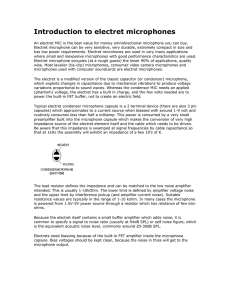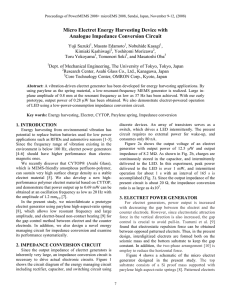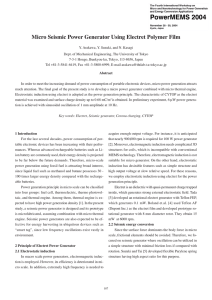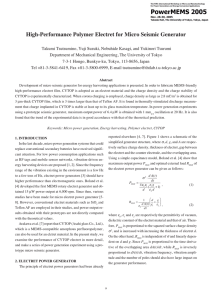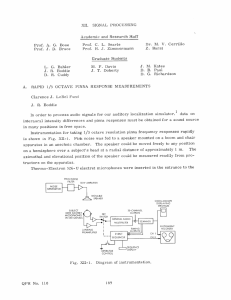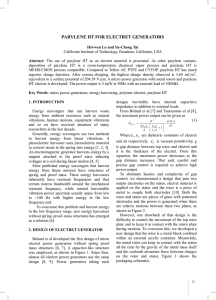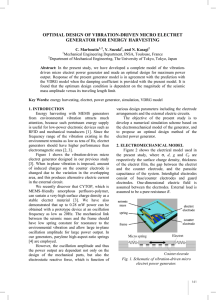IMPROVING AN ELECTRET ENERGY HARVESTER BY REDIRECTING THE ELECTRIC FIELD
advertisement
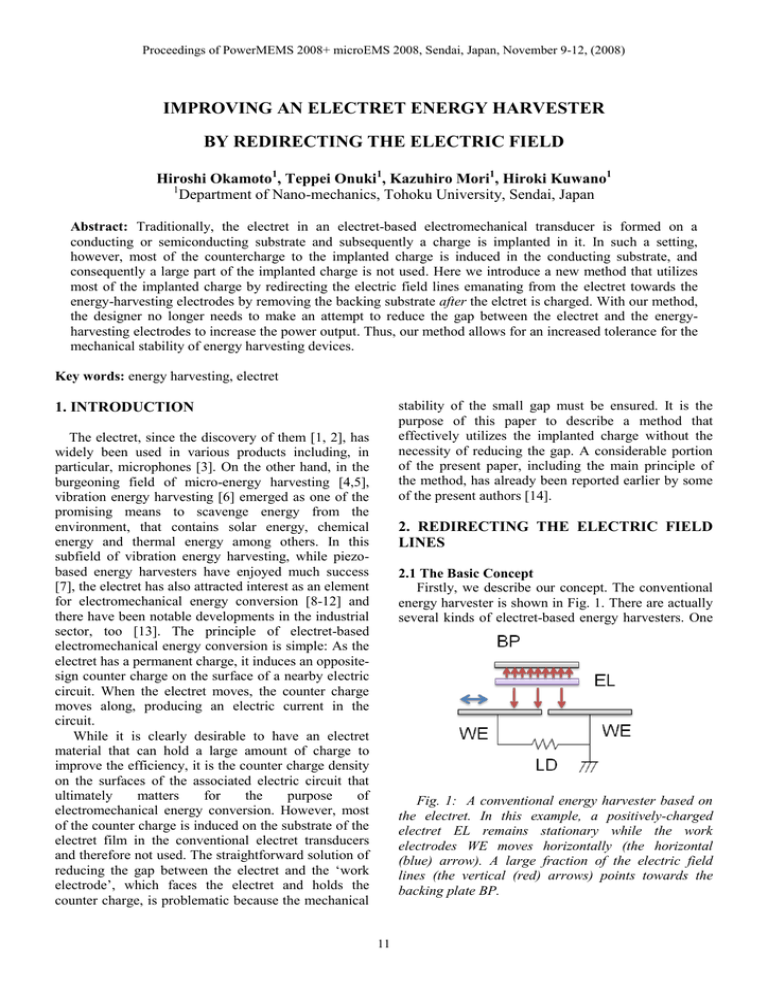
Proceedings of PowerMEMS 2008+ microEMS 2008, Sendai, Japan, November 9-12, (2008) IMPROVING AN ELECTRET ENERGY HARVESTER BY REDIRECTING THE ELECTRIC FIELD Hiroshi Okamoto1, Teppei Onuki1, Kazuhiro Mori1, Hiroki Kuwano1 1 Department of Nano-mechanics, Tohoku University, Sendai, Japan Abstract: Traditionally, the electret in an electret-based electromechanical transducer is formed on a conducting or semiconducting substrate and subsequently a charge is implanted in it. In such a setting, however, most of the countercharge to the implanted charge is induced in the conducting substrate, and consequently a large part of the implanted charge is not used. Here we introduce a new method that utilizes most of the implanted charge by redirecting the electric field lines emanating from the electret towards the energy-harvesting electrodes by removing the backing substrate after the elctret is charged. With our method, the designer no longer needs to make an attempt to reduce the gap between the electret and the energyharvesting electrodes to increase the power output. Thus, our method allows for an increased tolerance for the mechanical stability of energy harvesting devices. Key words: energy harvesting, electret stability of the small gap must be ensured. It is the purpose of this paper to describe a method that effectively utilizes the implanted charge without the necessity of reducing the gap. A considerable portion of the present paper, including the main principle of the method, has already been reported earlier by some of the present authors [14]. 1. INTRODUCTION The electret, since the discovery of them [1, 2], has widely been used in various products including, in particular, microphones [3]. On the other hand, in the burgeoning field of micro-energy harvesting [4,5], vibration energy harvesting [6] emerged as one of the promising means to scavenge energy from the environment, that contains solar energy, chemical energy and thermal energy among others. In this subfield of vibration energy harvesting, while piezobased energy harvesters have enjoyed much success [7], the electret has also attracted interest as an element for electromechanical energy conversion [8-12] and there have been notable developments in the industrial sector, too [13]. The principle of electret-based electromechanical energy conversion is simple: As the electret has a permanent charge, it induces an oppositesign counter charge on the surface of a nearby electric circuit. When the electret moves, the counter charge moves along, producing an electric current in the circuit. While it is clearly desirable to have an electret material that can hold a large amount of charge to improve the efficiency, it is the counter charge density on the surfaces of the associated electric circuit that ultimately matters for the purpose of electromechanical energy conversion. However, most of the counter charge is induced on the substrate of the electret film in the conventional electret transducers and therefore not used. The straightforward solution of reducing the gap between the electret and the „work electrode‟, which faces the electret and holds the counter charge, is problematic because the mechanical 2. REDIRECTING THE ELECTRIC FIELD LINES 2.1 The Basic Concept Firstly, we describe our concept. The conventional energy harvester is shown in Fig. 1. There are actually several kinds of electret-based energy harvesters. One Fig. 1: A conventional energy harvester based on the electret. In this example, a positively-charged electret EL remains stationary while the work electrodes WE moves horizontally (the horizontal (blue) arrow). A large fraction of the electric field lines (the vertical (red) arrows) points towards the backing plate BP. 11 Proceedings of PowerMEMS 2008+ microEMS 2008, Sendai, Japan, November 9-12, (2008) classification of these schemes is, for example, about the direction of motion of the electret. Whereas in one kind, the electret moves towards, or away from, the work electrode, in another kind of devices the electret moves „laterally‟, keeping the distance to the work electrodes constant. Figure 1 shows the latter. The charge on the electret (EL) induces a counter charge on the surface of the metallic work electrodes (WE). Since the EL moves relative to the WEs as a result of external vibration, the counter charge follows the motion, resulting in a current through the load (LD). In this conventional design, an electret film is formed on a metallic backing-plate (BP). The gap distance from the electret surface to the work electrode is larger than the electret film thickness for practical reasons because electret film thickness is usually measured in microns. The backing-plate is electrically grounded (not shown in the figure). Hence most of the electric field lines go to the backing-plate. In fact, when an electret with thickness d is formed on a conducting substrate, while having a gap g to the work electrodes, the induced surface charge density is given as , Fig. 3: A corona-charging device. The polarity of the charging can be in either way, even though negative-charge implantation is often preferred because of better charge stability. The absolute value of the high voltage HV is usually about several kV. The Grid electrode controls the final specimen surface potential. The typical value of grid electrode potential (in absolute value) is a few hundred to a thousand volts. WEs as shown in Fig. 2. This should be performed after the electret is corona-charged. Here is why the back-plate removal process should be carried out after the charge implantation. An electret is usually “corona-charged” initially, to get charge implanted on its surface. The corona-charge method is effective and widely used [15]. The typical structure of the corona-charge device, placed in the air rather than in a vacuum, is shown in Fig. 3. The grid electrode may or may not be present, but the important thing is that the final surface potential of the electret specimen is limited to a certain value, which usually is about 1 kV because of possible high voltage discharging in the setup. Given the upper limit of surface potential, higher surface charge density is obtained when the electret film is on a metal rather than an insulator during the charge implantation process. In Fig. 4, the thickness of the electret film, typically on the order of 10 micron, is exaggerated. Clearly, in the left, the length L of electric field lines from the implanted charge to the grounded metal is longer. The surface potential is given as = EL = DL/, where E, D, are respectively the electric field, the electric displacement field and the electric permittivity of the material. (We ignore the induced charge at the boundary between the electret and insulator with different permittivity, because the effect is negligible.) Thus, because of the identical surface potential determined by the corona-charging process, D must be much smaller if the electret film is on an insulator. (1) where , 0, , V are the implanted surface charge density of the electret, vacuum permittivity that is very close to the air permittivity, the dielectric constant of the electret material, and the voltage of the work electrode, respectively. It is that one would like to maximize in order to improve the efficiency of the energy harvester. In typical situations, the term involving V can be safely neglected. Hence, one immediately sees that having a large gap g compared to d would adversely affect the power conversion efficiency. In order to increase the induced charge density on the WEs, we remove the metallic BP from the electret film to redirect most of the electric field towards the Fig. 2: An improved energy harvester. The backing plate BP has been removed to redirect the electric field lines towards the work electrodes WE. 12 Proceedings of PowerMEMS 2008+ microEMS 2008, Sendai, Japan, November 9-12, (2008) advantageous. Needless to say, in this case the electret material must be attached to a grounded conductor during the charge implantation process. The film was corona-charged to 300 V while it was attached to a gold-coated copper plunger, which was shaped slightly convex. When the film was removed from the plunger, the surface potential increased to approximately 3 kV. Finally, to evaluate the proposed method, we used a small scale vibration energy harvester (Fig. 6) to evaluate the resultant electret film against an ordinary electret film that is formed on a metallic substrate. The power generation experiment indicated, in the particular case shown in Fig. 7, roughly 7 times improvement of the power generation efficiency. A conservative estimate that takes experimental uncertainties into account still suggests improvement factor of about 5. Fig. 4: The corona-charge implantation process in two different cases. On the left, the electret film is placed on an insulator, while on the right the electret is formed on a metal. In the case shown in the right, the implanted charge density is much higher when the corona-charging method is employed. The vertical (red) arrows represent electric field lines. See text. Consequently, the surface charge density is much smaller in this case because D = . 3. DISCUSSION There are still many things to be done. Firstly, despite the initial large electret surface potential of 3 kV right after removing the copper plunger, roughly 3 days later we found that the potential is usually reduced to a half, i. e., to ~ 1.5 kV. There must be some discharging process going on, that possibly involves moisture in the air. This issue must be addressed and clarified. The second aspect is about patterning. It is known since almost at the beginning of the electret power generator research that it is advantageous to pattern the electret to multiply the current output. The free-standing thin-film electret is obviously not a convenient form to achieve this. Methods to attach highly-charged electret film to an insulating substrate and also methods for its subsequent patterning will likely be needed. 2.2 Implementation of the Concept The idea described in the above has successfully been validated by our experiments. In the experiments, we produced a free-standing electret made of CYTOP [9]. We used a four-layers structure to ease the removal of a thin CYTOP layer from the substrate (Fig 5). The key for the removal process is the use of a glue layer. We used a standard commercial glue for office use (Arabic-Yamato, Yamato Co., Ltd.), which contains poly-vinyl alcohol as the main component. Evan though CYTOP, a fluoro-carbon polymer material, tightly sticks to nealy any material, it peels off from a heat-solidified glue layer with considerable ease. The use of the aluminum sheet, that could be removed from the solid copper substrate first, further makes it easier by allowing the entire structure to be „bent‟ before the peeling-off process. For this particular manufacturing process, we found that producing a free-standing film before charging, rather than removing the CYTOP layer after charging, is Fig. 5: The structure that enables a film of CYTOP electret material to be peeled-off from a substrate. The aluminum foil is inserted so that the hard copper substrate can be removed before the peeling-off process. Both glue and CYTOP are liquids before heat-solidification treatments, and they are spincoated during the process. Fig. 6: The energy harvester for evaluating the highly charged free-standing electret films. The principle is shown in Fig. 2. The entire system is fixed on a piezo-driven vibration generator. The resonant frequency of the resonator is approximately 231 Hz. Scale bar: 10 mm. 13 Proceedings of PowerMEMS 2008+ microEMS 2008, Sendai, Japan, November 9-12, (2008) [4] Z. L. Wang, Self-Powered Nanotech, Sci. Am. Jan, 82-87 (2007). [5] A. Kansal and M. B. Srivastava, An Environmantal Energy Harvesting Framework for Sensor Networks, in Proc. 2003 Int. Symp. on Low Power Electronics and Design (ISLPED03), ACM Press, 481-486 (2003). [6] C. B. Williams and R. B. Yates, Analysis of a micro-electric generator for microsystems, Sensors and Actuators, A52, 8-11 (1996). [7] See, e. g., Y. B. Jeon, R. Sood, J. –h, Jeong, and S.-G. Kim, MEMS Power Generator with Transverse Mode Thin Film PZT, Sensors and Actuators, A122, 16-22 (2005). [8] J. Boland, Y. H. Chao, Y. Suzuki, and Y. C. Tai, Micro Electret Power Generator, in Proc. MEMS 2003 Technical Digest, 538-541 (2003). [9] T. Tsutsumino, Y. Suzuki, N. Kasagi, K. Kashiwagi, Y. Morizawa, Efficiency Evaluation of Micro Seismic Electret Power Generator, in Proc. 23rd Sensor Symp., Takamatsu, Japan, 521524 (2006); Y. Sakane, Y. Suzuki, and N. Kasagi, High-performance Perfluorinated Polymer Electret Film for Micro Power Generation, in Proc. PowerMEMS 2007, 53-56 (2007). [10] H. W. Lo and Y. C. Tai, Parylene-HT-based Electret Rotor Generator, in Proc. MEMS 2008, 984-987 (2008). [11] T. Sterken, P. Fiorini, G. Altena, C. Van Hoof, and R. Puers, Harvesting Energy from Vibrations by a Micromachined Electret Generator, in Transducers and Eurosensors ’07, 129-132 (2007). [12] J. Zhang, Z. Chen, Y. Hao, Z. Wen, Y. Jin, and Z. Wen, PECVD SiO2/Si3N4 Double Layers Electrets for Application in MEMS Power Generator, in Technical Digest, PowerMEMS 2007, 105-108 (2007). [13] M. Loehndorf, T. Kvisteroy, E. Westby, and E. Halvorsen, Evaluation of Energy Harvesting Concepts for Tire Pressure Monitoring Systems, in Technical Digest, PowerMEMS 2007, 331-334 (2007). [14] H. Okamoto, T. Onuki, and H. Kuwano, Improving an Electret Transducer by Fully Utilizing the Implanted Charge, Appl. Phys. Lett., in press at the time of writing. [15] For a review of the recent developments, see J. A. Giacometti, S. Fedosov, and M. M. Costa, Corona Charging of Polymers: Recent Advances on Constant Current Charging, Braz. J. Phys., 29, 269-279 (1999). Fig. 7: The power output from the energy harvester shown in Fig 6. The power output is plotted against the excitation frequency of the vibration generator. The dotted (red) curve shows the power output when an electret was formed on a metal as usual. The continuous (blue) curve is the power output under the same condition except that a free-standing electret was employed. 4. CONCLUSION We have shown a method for fully utilizing the implanted charge in an electret material, thereby substantially improving the power output of an electret-based energy harvester. Even in this early stage of the development, an approximately 5-fold power output improvement has already been obtained in our particular experimental setup. However, it will be necessary to better characterize the electret in this new configuration and also to develop methods to fabricate them in a desired shape and/or pattern. ACKNOWLEDGMENT We sincerely thank Dr. Takashi Genda and Prof. Shuji Tanaka for kindly lending their homemade corona-charging triode to us. This work was conducted under the project “Research of a nano-energy system creation” (No. 18GS0203), funded by the Ministry of Education, Culture, Sports, Science and Technology (MEXT) of Japan. REFERENCES [1] M. Eguchi, On the Permanent Electret, Phil. Mag. 49, pp. 178-181 (1925). [2] For review, Marti Goel, Electret Sensors, Filters, and MEMS devices; New Challenges in Materials Research, Curr. Sci., 85, pp. 443-453 (2003). [3] G. M. Sessler and J. E. West, Electroacoustic Transducer, U.S. Patent #3, 118, 022 (1962). 14

